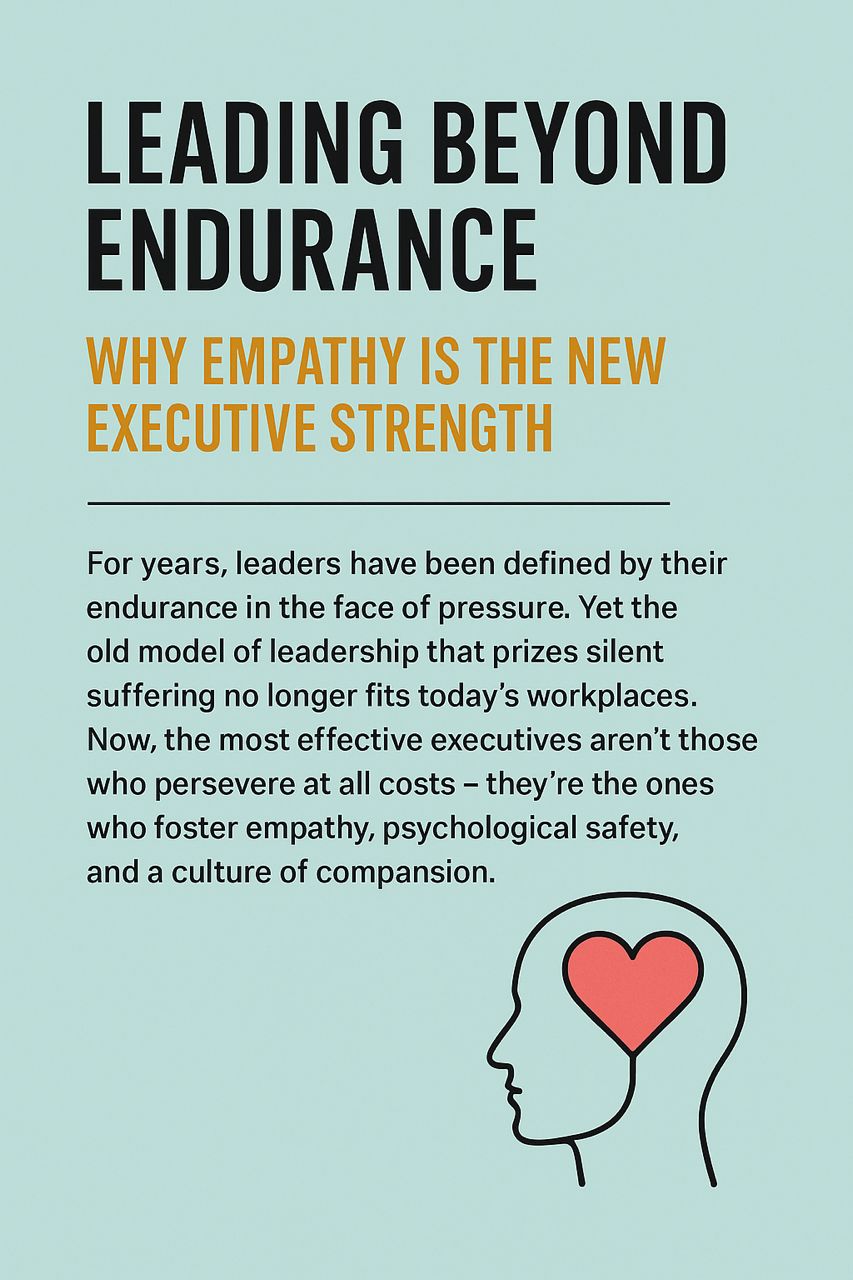
The Leadership Myth That Won’t Let Go
For years, the idea of a great leader has been tied to endurance, the ability to power through long hours, weather pressure in silence, and keep moving no matter the cost. It’s a familiar story: late nights, endless meetings, personal sacrifice, and quiet suffering all spun into a badge of honor.
But this narrative, while deeply ingrained, no longer fits the reality of modern leadership. In fact, it may be holding us back.
Endurance, on its own, is not leadership. And in today’s world, where innovation, agility, and well-being are non-negotiable, this outdated model is costing organizations their most valuable asset: their people.
Why the Endurance Model Fails
When we equate leadership with relentless stamina, we unintentionally glorify burnout. We send the message that exhaustion is proof of dedication and that vulnerability is weakness. But the data tells a different story.
Burnout is not just about tiredness; it’s a real psychological syndrome marked by emotional exhaustion, detachment, and a drop in performance. Yet in too many organizations, burned-out leaders are seen as heroic instead of overextended. The problem is, people are watching. And when employees see that the path to success requires personal depletion, they start opting out quietly or loudly.
A 2024 report by Businessolver found that over half of CEOs still associate mental health struggles with weakness. The result? A 23-point empathy gap between leaders and their teams. That’s not just a perception issue; it’s a trust issue. When leaders cannot model honesty about their limits, employees do not feel safe admitting theirs.
And that safety matters. Research from Catalyst shows that when employees feel their leaders are empathetic, 76% say they’re engaged at work, and two-thirds say they feel innovative. But under leaders who lack empathy? Innovation drops to 13%. That’s a steep fall. Without psychological oxygen, creativity cannot breathe.
A Shift in Thinking: From Survival to Support
We need to stop telling people that suffering is the price of leadership, because it’s not. In truth, the strongest leaders today are not those who push through everything; they are the ones who recognize when someone needs help and create space for it.
The new leadership mindset is clear: it’s not “what doesn’t kill you makes you stronger,” but “what supports you helps you soar.”
Compassion matters here, not just in theory, but in practice. A global study on human-centered leadership found that compassionate leaders reduce burnout by over 60%, lower stress levels dramatically, and increase employee loyalty. Stephen Covey makes an important distinction: empathy is understanding, but compassion is acting on that understanding. It’s not soft, it’s strategic.
Empathy, too, is far from a feel-good skill. Studies by Franklin Covey show that over 80% of employees say empathy drives job satisfaction and innovation. Yet fewer than half of senior leaders practice it. That gap is not just cultural, it’s costing real performance.
What Today’s Best Leaders Do Differently
Modern executives are rewriting the leadership playbook. Here’s what they’re doing instead:
- They understand that resilience is not about staying silent through stress, but about bouncing back, with help. They invest in coaching, reflection, and systems that protect their energy and their teams’.
- They practice empathy in motion. Listening is step one, but action is what builds trust. Whether it’s changing a policy, creating flexibility, or just checking in, great leaders follow through.
- They know that their legacy is not about how much they endured, but how much they made it easier for the next person. They remove obstacles, not replicate them.
- And most importantly, they see organizational culture not as fluff, but as infrastructure. When culture supports mental health, inclusion, and flexibility, it becomes a business advantage, one that is hard to replicate and even harder to beat.
Practical Shifts for Executive Teams
If this sounds like a philosophy shift, it is, but it is also very practical. Here are five actions leaders can take today:
- Reframe Your Own Story: Do not just share how hard it was. Share what you learned, and what you would do differently, so others do not have to go through the same.
- Create Safety in the Room: Ask more questions than you answer. Invite dissent. Normalize being wrong. That’s how psychological safety begins.
- Build Peer Support: Leaders need care, too. Peer check-ins, roundtables, and even quiet moments of vulnerability go a long way in building collective strength.
- Train for Empathy: Equip leaders not just to care, but to care sustainably. Teach active listening, emotional boundaries, and how to avoid empathy fatigue.
- Measure What Matters: If you only track profits and outputs, people will feel like inputs. Start measuring team well-being, burnout risk, and trust levels. What gets measured improves.
This Is Not a Trend, It’s a Transformation
The model of leadership we inherited, one built on silent strength, personal sacrifice, and rugged survival, is no longer enough. We are leading in a world where uncertainty is constant, work is deeply personal, and talent has options. In this world, empathy is not a side note. It’s a cornerstone.
Leaders who support others not only get better results, but they also build better companies; more agile, more human, more resilient.
As Simon Sinek put it, “Leadership is not about being in charge. It’s about taking care of those in your charge.”
We do not dismiss resilience, we just redefine it. Real resilience is shared, supported and strategic.
Lead with strength. Lead with empathy. That’s leadership that lasts.
References
- https://www.businesswire.com/news/home/20240612177626/en/Businessolver-2024-Empathy-Study-55-of-CEOs-Say-Theyve-Experienced-a-Mental-Health-Issue-Up-24-Points
- https://www.harvardbusiness.org/insight/empathetic-leadership-how-to-go-beyond-lip-service/
- https://time.com/4886913/how-to-take-care-of-others-without-burning-out/
- https://www.forbes.com/sites/cherylrobinson/2025/02/24/leaders-are-you-feeling-fatigued-you-could-be-experiencing-empathy-burnout/

